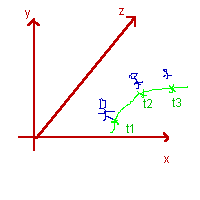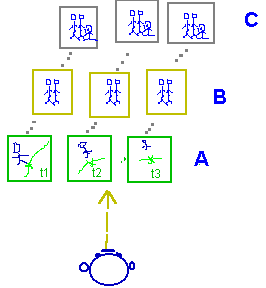

Today's way of viewing of time and space is leaning towards the assumption that the player moves within space and along a fixed path of time:

This view has invaded most parts of the Eastern hemisphere as well. However, an ancient Iranian religion, according to some the first recorded religion at all, asserts that the view of 'moving in space' is not only incorrect but also the trap that holds a Being into this Universe.
Its view is based on the perspective of this world as an interference pattern of 'vibrations' which is experiencable only as a series of flashes (cp. the time-quantum theory, explained elsewhere in the Notebook).
However, in contrast
to the prevailing 'common thinking/feeling', the observer (the 'Being'
or 'player') occupies a transcendent and _non-moving_ position in respect
to
this Universe.
Only via the improper identification of the Being with parts of the Universe, especially human bodies, of course, can the Being be made believe that _itself_ would move through space along a fixed time line.
Again, in truth, so was the assertion, there is no 'path' through space but only through time. Remembering, except by using secondary (created) body reactions and circuits, would then be seen as 'moving naturally' around in time.
Once the Being would realize this circumstance, it would become independent again from the illusions of this Universe, hence embracing 'nirvana'.
If not, it would be so hypnotized by the show that it would want to see the 'Titanic' movie a million times.
The secret mystery of the 'static observer' that was only accessible to the 'wisest of the wisest', is now within reach of every of our pre-teen kid.
The last two decades have made it possible to reexperience this view with the help of computer technology.
To begin with, here is an illustration of the time-quantum sequence containing the illusion of space:
In a movie theater the observer sits in front of a giant screen. The movie consists of a series of single pictures with darkness in between. This is exactly the same structure as the ancient 'vibrationists' were suggesting.

Now, in a movie theater there are no controls to change the pre-fab show. The only choice an observer has is to leave the theater before the end of the movie. 'Leaving the theater' would be in our context similar to 'escaping from this Universe' or 'entering nirvana'.
Leaving a play prematurely is seen by many as very rude and anyone suggesting it is easily condemned by traditional _and_ 'modern' thinkers alike.
However, this model is still very incomplete and an expansion can change this viewpoint dramatically.
The next degree of 'freedom', compared to the seat of a movie goer, is the TV set with multiple, parallel channels. Just recently, satellite TV in the US has stepped up to the potential of 500 (fivehundred) concurrent channels (and nothing on!).
What if the Universe-theater would have an unlimited number of channels and any two adjacent channels would be only slightly different? Then, a remote control could navigate someone through a jungle of endless possibilities. Which, is, of course, LIFE!
The position within such a 'holographic' world would then be determined by the adjustments to the viewing apparatus, for example the focus of the beam generator in the 'hologram model', rather than 'really' moving through space.

These 'adjustments' or 'choices' would result in a person to decide to experience a life living alone ('A'), or at a certain 'time' marry someone ('B'), and, perhaps, to have kids ('C').
In this model, all
these possibilities already 'exist' in the hologram and a person 'switches'
to different experience frames by means of the choices it is doing in the
course of playing
the game.
Nowadays, any kid can do that on a lower, fractal harmonic: computer games, sometimes pretentiously called 'virtual reality'.
Again, the kid or player does NOT move in front of the computer screen, the only thing that moves is the joy stick.
In an astonishing twist of fate, our kids may now be acting like the 'wisest of the wisest'!
If they could or would translate the computer game player's viewpoint into the 'real' world, that is.
It is a veritable blessing that they don't! Most (all?) computer games are extremely violent, after all.
The viewpoint of a
'static observer' can be reached through some practice even without a computer.
If one becomes aware of the spatial relationships (size and location of
objects)
while one is walking
around in house or nature, one can train one's mind to _see the door coming
towards oneself_ rather than going towards the door. In other words, oneself
would not 'move' but
one would decide how the picture of the world would move around in
front of one's viewing field.
Now back to the accusation that leaving the game early would be sneaking out or abandoning the rest of the players.
Since, in this model, time is not a fixed sequence, the perception of an 'end of the game' or an 'end of time' becomes an illusion.
Because, in this model, the 'end' is just a location in the hologram (and there may be many different 'ends', for that matter).
In other words, it
becomes completely irrelevant at WHAT location in the hologram one would
withdraw and exercising the nirvana option does not mean that one could
not reenter
the game at any point
'in time' (which means at any place in the hologram).
It also means, one could circle around in the hologram virtually 'forever' without reaching its end.
In any case, let's kick the kids off the computers and let's do some serious gaming now, OK!